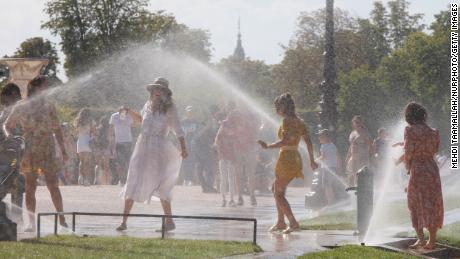The results were based on data from a 10-day period around the end of July. The monitor said 45% of the land was now covered by ‘warnings’ meaning there is a moisture deficit in the soil, while 15% is below the more severe ‘alert’ level. , where the vegetation is stressed.
The data coincided with a report released Monday by Europe’s climate monitoring agency Copernicus, which said much of Europe experienced a drier than average July, with several local records broken in the west for low rainfall and drought hitting parts of southwestern and southeastern Europe.
The new data comes as the world grapples with a food crisis that is only easing as Russia lifts its blockade on grain exports from Ukraine. Severe weather and supply chain issues have compounded the crisis and are expected to persist for some time.
A recent report by the Joint Research Centre, the scientific service of the European Commission, predicts an 8-9% drop in grain maize, sunflower and soybean production in the EU due to hot and dry conditions in the EU. summer, well below the five -annual average.
Copernicus lead scientist Freja Vamborg said “the dry conditions of previous months combined with the high temperatures and low precipitation rates seen in many regions in July may have adverse effects on agricultural production and other industries. such as river transport and energy production”.
Months with little rain
In July, water reservoirs in several parts of Europe were at very low levels, insufficient to support demand, according to Copernicus.
Southern England had its driest July since records began in 1836, while the month across the UK was the driest July for more than 20 years. The UK recorded just 46.3mm, or 56%, of its average rainfall for the month after a long string of drier than average months with the exception of February.
In France, the month of July recorded a total rainfall of 9.7 mm, which makes it the driest month of July since records began in 1959 and represents a rainfall deficit of 85% compared to the 1991 average. -2020.
Copernicus said the situation had improved thanks to rainfall towards the end of the month, which caused the river to rise by 40cm, although hydroelectric production in the region was still affected.
July was also one of the three hottest months in the world, nearly 0.4 degrees Celsius above the 1991-2020 average, and the sixth hottest July in Europe, Copernicus said. .
Meanwhile, Spain reported its hottest July in more than 60 years on Monday.
“July 2022 was extremely hot in Spain, the hottest since at least 1961, with an average temperature of 25.6 ºC [78.1 Fahrenheit]i.e. 2.7 ºC [4.9 Fahrenheit] higher than the normal average,” the country’s national meteorological agency AEMET said in a post on Twitter. July was “0.2 ºC [0.4 Fahrenheit] higher than July 2015, which was the hottest July so far,” he added.
CNN’s Benjamin Brown and Molly Stazicker also contributed to this report from London.

